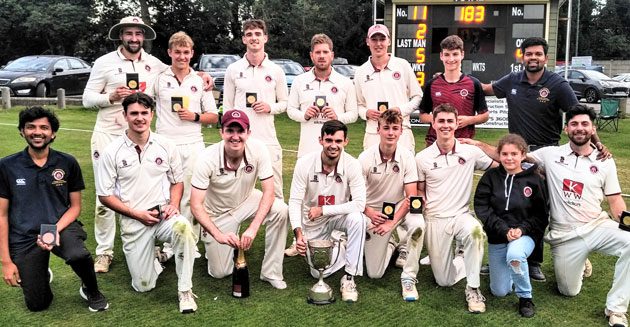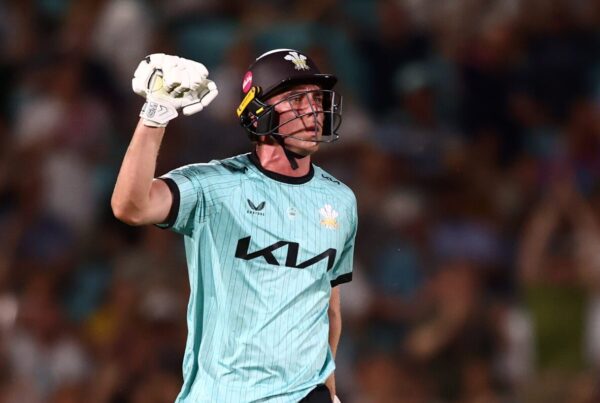Throughout the winter we will look at each department of the Surrey Cricket Foundation and its work in the county. This month we focus on how it improves adult cricket in the region.
Richard Spiller reports below.
—
While the pandemic has wreaked havoc in so many aspects of life, adult cricket in Surrey has been one of the areas which has grown.
More than 30 new teams joined leagues in 2021, building on a boom in participation which took place the previous season, one which had seen lockdown restrictions preventing any play in the first half of the summer but saw players old and new desperate to get to the middle in what was left.
That played a part in cricketers of all ages enjoying 14,998 matches last season, an upsurge of 30% since 2019. How do we know? It’s all in a day’s work for Simon Hards, Assistant Director of Cricket Participation for the Surrey Cricket Foundation.
“Our role is to work closely with the leagues and clubs, offering support and advice,” explains Hards, the extra complications of the pandemic making that all the more important.
“We held meetings on a very regular basis to deal with the rules and protocols for the return to cricket in the early part of the pandemic. All the leagues are independent organisations and one of the many things they have in common is a desire to increase the number of people playing the game.
“We were pleasantly surprised by the rise in numbers which sprang from 2020, whether it was through newcomers to the game or players returning after time away. Some clubs were on their knees midway through that season, having had no cricket, but it proved a boon in the end.
“There was a concern that the more normal pattern to life of last summer might mean a greater number of games being conceded but that didn’t happen, with concessions lower than they had been during our World Cup winning year in 2019.
“How long-term the growth trend proves to be is something we will only find out in the coming years but it’s encouraging. There are more options now in terms of format with cricket to suit all needs whether that be short, medium or longer game lengths, whereas 10 years ago that wasn’t quite as much the case.
“We have a Zoom chat with every league which wants to join in – and the vast majority do – four times a year. They know they are all valued and can learn from each other, particularly at times like these.”
The Foundation conducts an annual survey among recreational cricketers which offers an opportunity for them to give their views, Hards commenting: “We’ve had more than 2,000 responses this year and that’s a fantastic way of finding out what sort of cricket players want and their views. It’s a great resource in helping leagues to initiate conversations with the clubs in their competitions about potential changes.”
An even greater upsurge in junior cricket in Surrey – next year there are expected to be over 1,500 teams involved – is particularly encouraging for the adult game but also means clubs must be prepared.
“If clubs are going to expand, they need to be prepared. Greater numbers means you need more qualified coaches, which is a legal requirement, and they have to be trained. Just as important is that if clubs are going to field more teams, they need grounds to play on. We are working hard to try and ensure we can support in both these areas.
“We know finding new places to play is particularly hard, especially in the London boroughs which are so built up.
“We’re working with the London Cricket Trust and the local authorities to get cricket back into London’s Parks and a major element of that is installing non-turf pitches. They are much easier to maintain for local authorities and cut costs to clubs.
“They have met with quite a lot of resistance in the past but have improved a lot with a number of clubs across Surrey using them regularly now and reporting positive experiences. As the game continues to grow we will need to adopt a wider use of these types of surfaces, something that is common place within recreational cricket in Australia.”
One of the great successes of recreational cricket in the county has been the launch and growth of the Surrey Slam, offering short-form games on weekdays and or weekends, which has introduced hundreds of newcomers or returning players to the game since its inception. Sussex inaugurated their own Slam in 2020 and Hampshire will do so next year.
Hards is always seeking new frontiers for recreational cricket and was delighted when Epsom, Cobham and Pirbright began playing walking cricket, building on the successes of football and rugby versions.
He said: “Diversity is so important to us and that covers a wide range of areas including age. Walking cricket is another way for our older players who might not be involved in the game anymore or who are trying to maintain an interest to do so. We are looking to support more clubs to start offering walking cricket as we move into 2022.
“We believe it could provide clubs with a great additional offering for their local communities and walking cricket is an activity that can be easily set up and delivered at times when the club would otherwise not be open, increasing usage and revenues for the clubs involved.
“We have programmes for five-year-olds and walking cricket can stretch that all the way to 80-plus, meaning a lifetime playing the game.”










